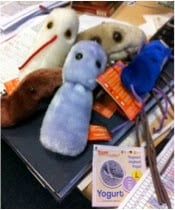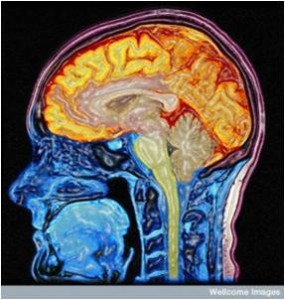This is the first in a series of posts exploring the science of Star Trek, courtesy of our friends at the Scouse Science Alliance. In this first post we delve into the real-life biology of everyone’s favorite purring ball of destruction – the Tribble!
 These cute, fluffy, purring balls of joy are considered a mortal enemy of the Klingon Empire (Klingons are a warrior race who love a good battle, and in Kirk’s era they were often the bad guys). They notoriously multiplied uncontrollably on board the USS Enterprise under Captain Kirk in the episode ‘The Trouble with Tribbles’. Starfleet considers them dangerous organisms and forbids them from transport. Despite their purring nature towards humans, the same is not true of Klingons. In fact, Kirk used a Tribble to identify a Klingon in disguise. The Tribble reacted with a screeching noise. Now, how exactly do these fluffy little puffs manage to multiply at such extreme rates? Cleverly, each Tribble is ‘born pregnant’ and if given the smallest morsel of food, will give birth to 10 Tribbles, who in turn will also produce 10 Tribbles. Within hours you have hundreds of Tribbles, clogging up every console, air vent, and food replicator [2].
These cute, fluffy, purring balls of joy are considered a mortal enemy of the Klingon Empire (Klingons are a warrior race who love a good battle, and in Kirk’s era they were often the bad guys). They notoriously multiplied uncontrollably on board the USS Enterprise under Captain Kirk in the episode ‘The Trouble with Tribbles’. Starfleet considers them dangerous organisms and forbids them from transport. Despite their purring nature towards humans, the same is not true of Klingons. In fact, Kirk used a Tribble to identify a Klingon in disguise. The Tribble reacted with a screeching noise. Now, how exactly do these fluffy little puffs manage to multiply at such extreme rates? Cleverly, each Tribble is ‘born pregnant’ and if given the smallest morsel of food, will give birth to 10 Tribbles, who in turn will also produce 10 Tribbles. Within hours you have hundreds of Tribbles, clogging up every console, air vent, and food replicator [2].
Is such a creature possible I hear you ask? Well, being a hermaphrodite is nothing new. Snails and plants are examples of this. They possess both male and female reproductive organs, although the female organs of one snail will normally mate with the male organs of another snail, i.e. sexual reproduction. However, in some hermaphrodites self-fertilization can occur [3]. Then there are those species that are able to effectively create clones of themselves via asexual reproduction, such as stick insects. The advantage of asexual reproduction is that it is a relatively quick way to populate an environment, and it does not rely on regular encounters with the opposite sex. It is considered most advantageous in favourable, stable environments. The down side is the inevitable lack of genetic diversity, which would be particularly problematic if conditions became unfavourable. Despite this, some stick insects have been shown to survive for a million years without sexual reproduction, suggesting that this method is genetically sustainable [4].
Therefore, it is very plausible that Tribbles are able to produce offspring in the absence of another Tribble. The only questionable aspect is the sheer speed at which they accomplish this. The shortest gestation period known currently for a mammal on earth is 12 days for the opossum. This animal is a marsupial and whilst it has a very short gestation period, its young are born almost foetal-like and therefore require nursing in the mother’s pouch for an extended period of time before reaching maturity [5]. With regards to Tribbles, not only would their gestation period have to take place in a matter of hours, but the ‘baby’ Tribblewould also have to reach maturity in an equally rapid manner.
If this could actually be achieved, then it would be a huge survival advantage. To be able to maximise breeding potential and minimise the energy intake required t o do so, is the ambition of all species. What’s more, this rapid production of generations would only serve to increase mutation rates, which in some instances can help species adapt. In fact, much of this can be likened to microbes such as viruses and bacteria. Their rapid succession of generations allows them to adapt much more quickly than us, their human hosts. Therefore Tribbles are merely a victim of their own success. All they want is to eat and breed as efficiently as possible, who doesn’t? So in conclusion, Tribbles are quite like microbes, and microbes aren’t so bad. In fact, they can be quite cute and fluffy too!
o do so, is the ambition of all species. What’s more, this rapid production of generations would only serve to increase mutation rates, which in some instances can help species adapt. In fact, much of this can be likened to microbes such as viruses and bacteria. Their rapid succession of generations allows them to adapt much more quickly than us, their human hosts. Therefore Tribbles are merely a victim of their own success. All they want is to eat and breed as efficiently as possible, who doesn’t? So in conclusion, Tribbles are quite like microbes, and microbes aren’t so bad. In fact, they can be quite cute and fluffy too!
 This post, by author Bryony Parsons, was kindly donated by the Scouse Science Alliance and the original text can be found here.
This post, by author Bryony Parsons, was kindly donated by the Scouse Science Alliance and the original text can be found here.
References
- http://www.edparsons.com/2006/03/google-earth-inspiration-was-star-treks-tricorder/
- Okuda, M. and Okuda, D. 1997. The Star Trek Encyclopaedia, a reference guide to the future. Updated and expanded edition. POCKET BOOKS, USA. P 522.
- Campbell, N. A. and Reece, J. B. Biology, sixth edition. Pearson Education, Inc, USA. P 975-978.
- http://www.bbc.co.uk/nature/14122050
- http://www.opossumsocietyus.org/opossum_reproduction_and_life_cycle.htm



















